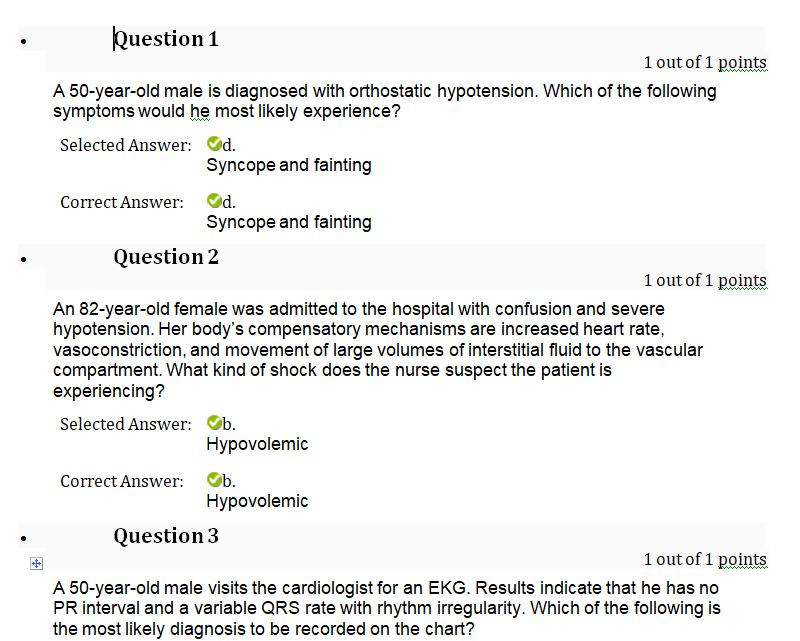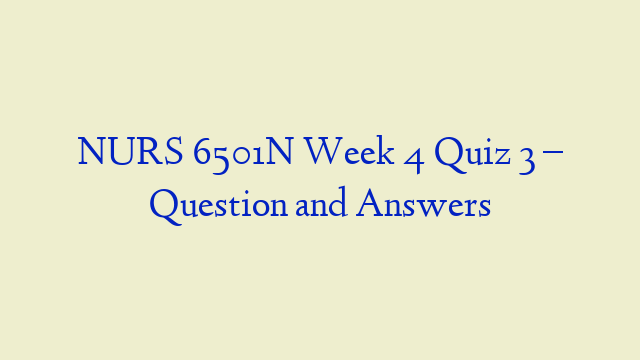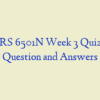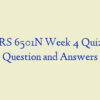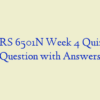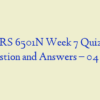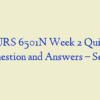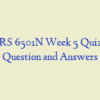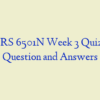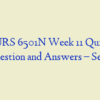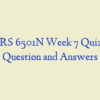Description
NURS 6501N Week 4 Quiz 3 – Question and Answers
- A 50-year-old male is diagnose with orthostatic hypotension. Which of the following symptoms would he most likely experience?
- An 82-year-old female was ….to the hospital with confusion and severe hypotension. Her body’s compensatory mechanisms are increased heart rate, vasoconstriction, and movement of large volumes of interstitial fluid to the vascular compartment. What kind of shock does the nurse suspect the patient is experiencing?
- A 50-year-old male visits the cardiologist for an EKG. Results indicate that he has no PR interval and a variable QRS rate with rhythm irregularity. Which of the following is the most likely diagnosis to be recorded on the chart?
- Which condition should cause the nurse to assess for high-output failure in a patient?
- A 50-year-old female presents with a low heart rate and low blood pressure. She is ….an intravenous (IV) infusion of fluids. The increase in atrial distension results in:
- A 5-year-old female is found to have hypertension during three separate visits to her primary care provider. The nurse would expect tests to suggest that the hypertension is secondary to:
- A 56-year-old male is ….with coronary artery disease. Which of the following modifiable risk factors would the nurse suggest the patient change?
- Most cases of ….systolic and diastolic hypertension have no known cause and are documented on the chart as _____ hypertension.
- A 52-year-old male presents with pooling of blood in the veins of the lower extremities and edema. The diagnosis is chronic venous insufficiency, and an expected assessment finding of this disorder is:
- Many valvular stenosis and regurgitation disorders in adults have a common etiology. Which of the following conditions should alert the nurse that the patient may have both types of valve dysfunction?
- While planning care for a patient with superior vena cava syndrome (SVCS), which principle should the nurse remember? SVCS is a progressive _____ of the superior vena cava (SVC) that leads to venous distention of the upper extremities and head.
- When a nurse checks the patient for orthostatic hypotension, what did the nurse have the patient do?
- A 50-year-old obese male with hypertension and coronary artery disease visits a nutritionist for food counseling. He has an elevated level of low-density lipoprotein (LDL) and a low level of high-density lipoprotein (HDL). Which of the following should the nurse advise him to avoid?
- A 68-year-old female is experiencing left heart failure. Physical exam reveals elevated blood pressure. The nurse understands this is most likely …..by:
- A 28-year-old female presents with severe chest pain and shortness of breath. She is diagnose with pulmonary embolism, which most likely originated from the:
- Which characteristic changes should the nurse keep in mind while caring for a patient with left heart failure? As left heart failure progresses nurs 6501n week 4 quiz
- When a patient has a massive pulmonary embolism (PE), what complications will the nurse monitor for?
- A 51-year-old male is at the health clinic for an annual physical exam. After walking from the car to the clinic, he developed substernal pain. He also reported discomfort in his left shoulder and his jaw, lasting 2 to 3 minutes and then subsiding with rest. He indicates that this has occurred frequently over the past few months with similar exertion. The nurse suspects he is most likely experiencing:
- A 54-year-old male is diagnose with left bundle branch block. Which of the following structures would not receive an electrical impulse?
- A 30-year-old Caucasian female was recently ….with primary hypertension. She reports that she eats fairly well, usually having red meat and potatoes daily. She also reports that her father has hypertension as well. A nurse determines which of the following risk factors is most likely ….with this diagnosis?
- A 60-year-old male is diagnose with cerebral aneurysm. Where does the nurse suspect the cerebral aneurysm is located?
- A nurse monitors the patient for _____ when rapid onset of malignant hypertension results nurs 6501n week 4 quiz
- Which of the following findings in the patient with Raynaud disease would indicate a need for further teaching?
- A 59-year-old female is diagnose with left ventricular failure. If a decrease in kidney perfusion occurs, the nurse knows this would ultimately cause:
- A 50-year-old male with a 30-year history of smoking was …..with bronchogenic cancer. He developed edema and venous distention in the upper extremities and face. Which of the following diagnosis will the nurse observe on the chart?
- An 80-year-old female is in the hospital for a bone fracture. While there she develops a large, nonlethal pulmonary embolus. Which of the following is a direct result of the obstruction to pulmonary blood flow?
- A 32-year-old female presents with lower leg pain, with swelling and redness. While obtaining the patient’s history, which finding could have caused her condition?
- A 50-year-old male is …..with pulmonary embolism (PE). Which of the following symptoms most likely occurred before treatment?
- A 70-year-old female is in the hospital for pelvic fracture. She develops pulmonary thromboembolism. The nurse realizes this embolus is …..of:
- A patient wants to know what causes atherosclerosis. How should the nurse respond? In general, atherosclerosis is caused by nurs 6501n week 4 quiz
